Masters Project: Lean Six Sigma Implementation in Aircraft Maintenance
VerifiedAdded on 2021/05/27
|22
|6278
|41
Project
AI Summary
This project, aimed at a Master's level, investigates the application of Lean Six Sigma principles to enhance aircraft maintenance, repair, and overhaul (MRO) processes within the aviation industry. The study focuses on improving service quality, reducing maintenance cycle times, and addressing critical quality issues (CTQ). The research employs a literature review to analyze the integration of Lean Six Sigma with MRO practices, including value stream mapping, and proposes solutions for optimizing various aspects of aircraft maintenance, such as wheel overhauling, mechanical equipment, and spare parts management. The project highlights the importance of supply chain management in MRO and suggests future research directions to further refine these processes. The project aims to provide recommendations for reducing costs, increasing productivity, and improving customer satisfaction through the implementation of Lean Six Sigma frameworks.
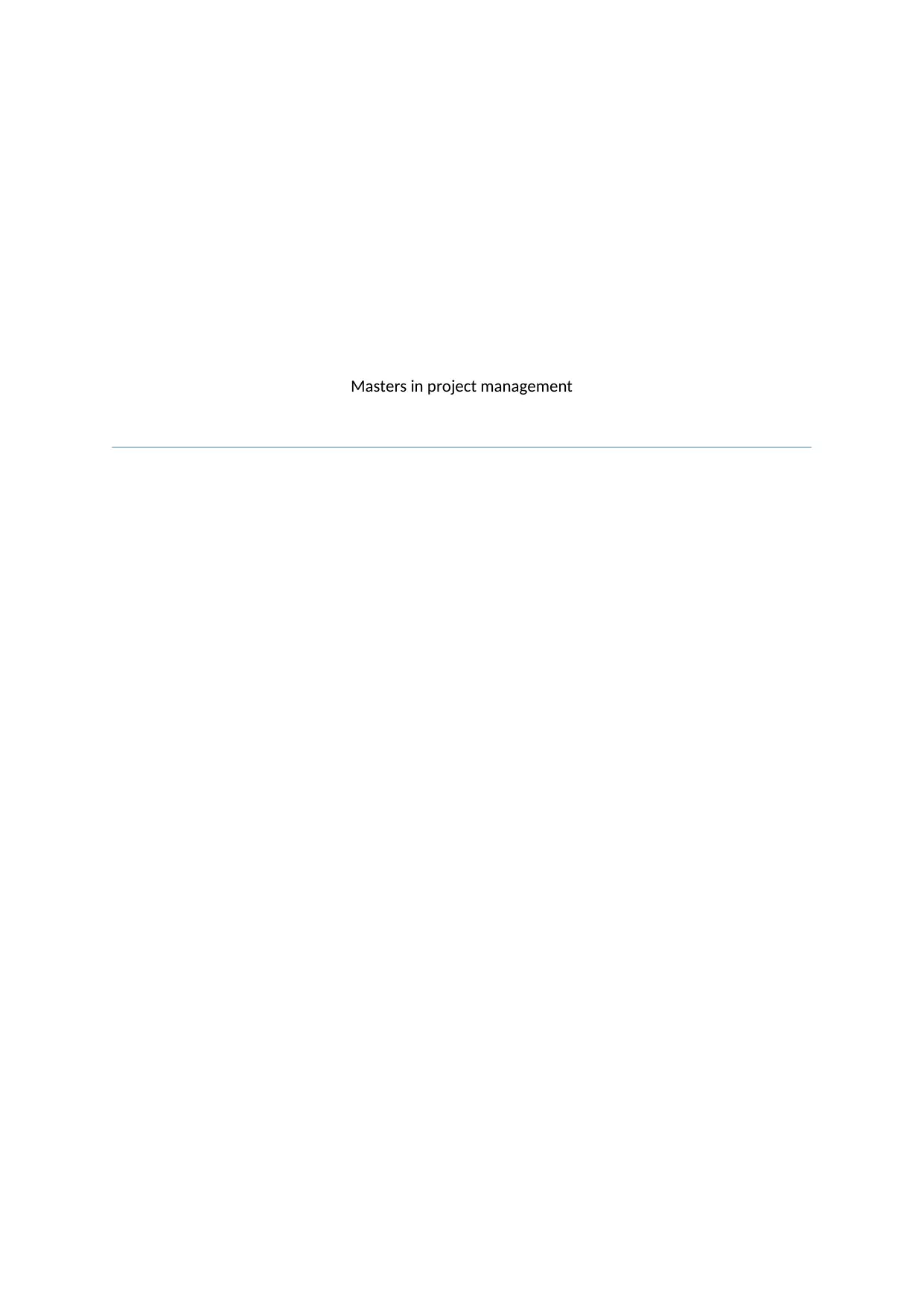
Masters in project management
Paraphrase This Document
Need a fresh take? Get an instant paraphrase of this document with our AI Paraphraser
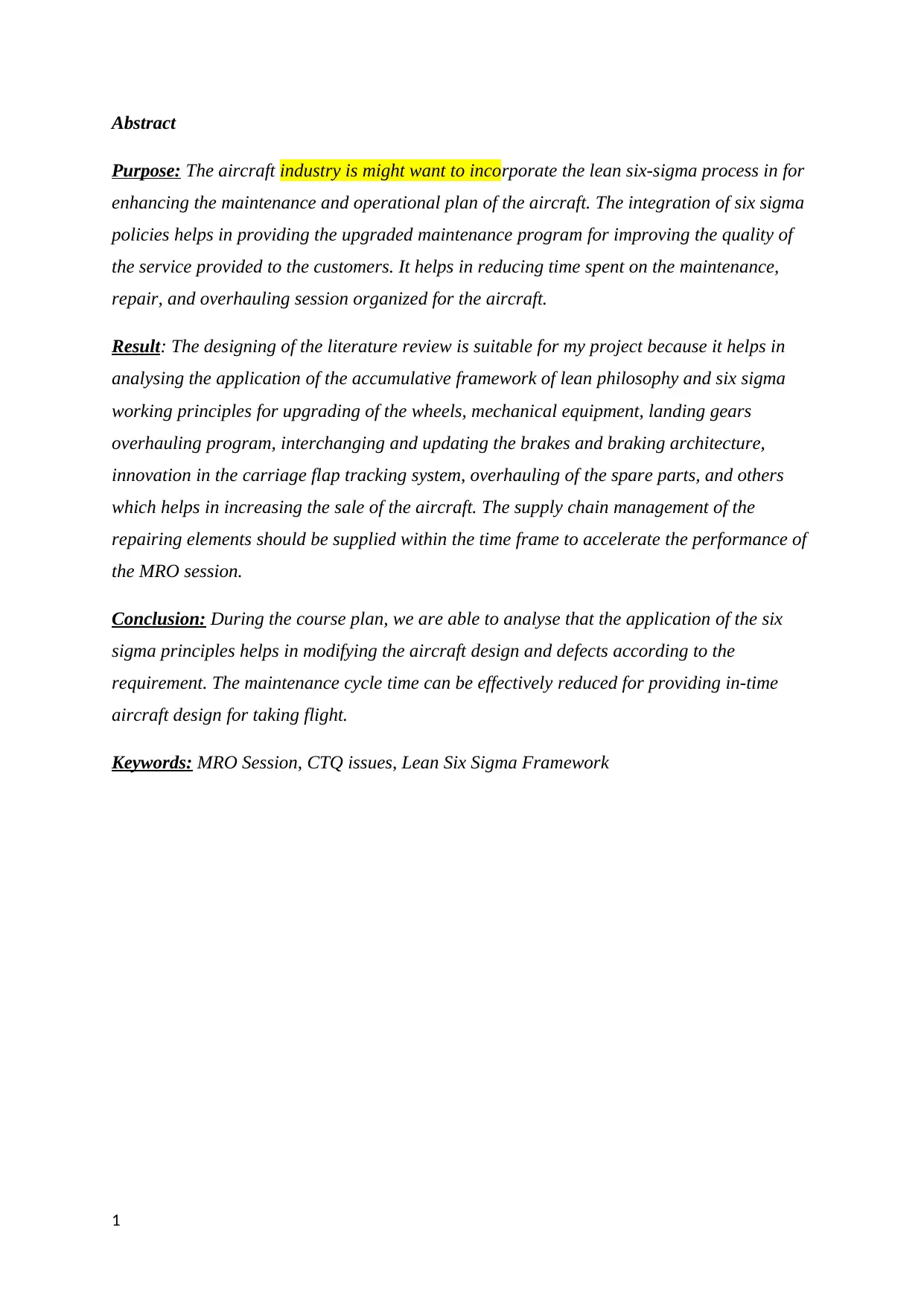
Abstract
Purpose: The aircraft industry is might want to incorporate the lean six-sigma process in for
enhancing the maintenance and operational plan of the aircraft. The integration of six sigma
policies helps in providing the upgraded maintenance program for improving the quality of
the service provided to the customers. It helps in reducing time spent on the maintenance,
repair, and overhauling session organized for the aircraft.
Result: The designing of the literature review is suitable for my project because it helps in
analysing the application of the accumulative framework of lean philosophy and six sigma
working principles for upgrading of the wheels, mechanical equipment, landing gears
overhauling program, interchanging and updating the brakes and braking architecture,
innovation in the carriage flap tracking system, overhauling of the spare parts, and others
which helps in increasing the sale of the aircraft. The supply chain management of the
repairing elements should be supplied within the time frame to accelerate the performance of
the MRO session.
Conclusion: During the course plan, we are able to analyse that the application of the six
sigma principles helps in modifying the aircraft design and defects according to the
requirement. The maintenance cycle time can be effectively reduced for providing in-time
aircraft design for taking flight.
Keywords: MRO Session, CTQ issues, Lean Six Sigma Framework
1
Purpose: The aircraft industry is might want to incorporate the lean six-sigma process in for
enhancing the maintenance and operational plan of the aircraft. The integration of six sigma
policies helps in providing the upgraded maintenance program for improving the quality of
the service provided to the customers. It helps in reducing time spent on the maintenance,
repair, and overhauling session organized for the aircraft.
Result: The designing of the literature review is suitable for my project because it helps in
analysing the application of the accumulative framework of lean philosophy and six sigma
working principles for upgrading of the wheels, mechanical equipment, landing gears
overhauling program, interchanging and updating the brakes and braking architecture,
innovation in the carriage flap tracking system, overhauling of the spare parts, and others
which helps in increasing the sale of the aircraft. The supply chain management of the
repairing elements should be supplied within the time frame to accelerate the performance of
the MRO session.
Conclusion: During the course plan, we are able to analyse that the application of the six
sigma principles helps in modifying the aircraft design and defects according to the
requirement. The maintenance cycle time can be effectively reduced for providing in-time
aircraft design for taking flight.
Keywords: MRO Session, CTQ issues, Lean Six Sigma Framework
1
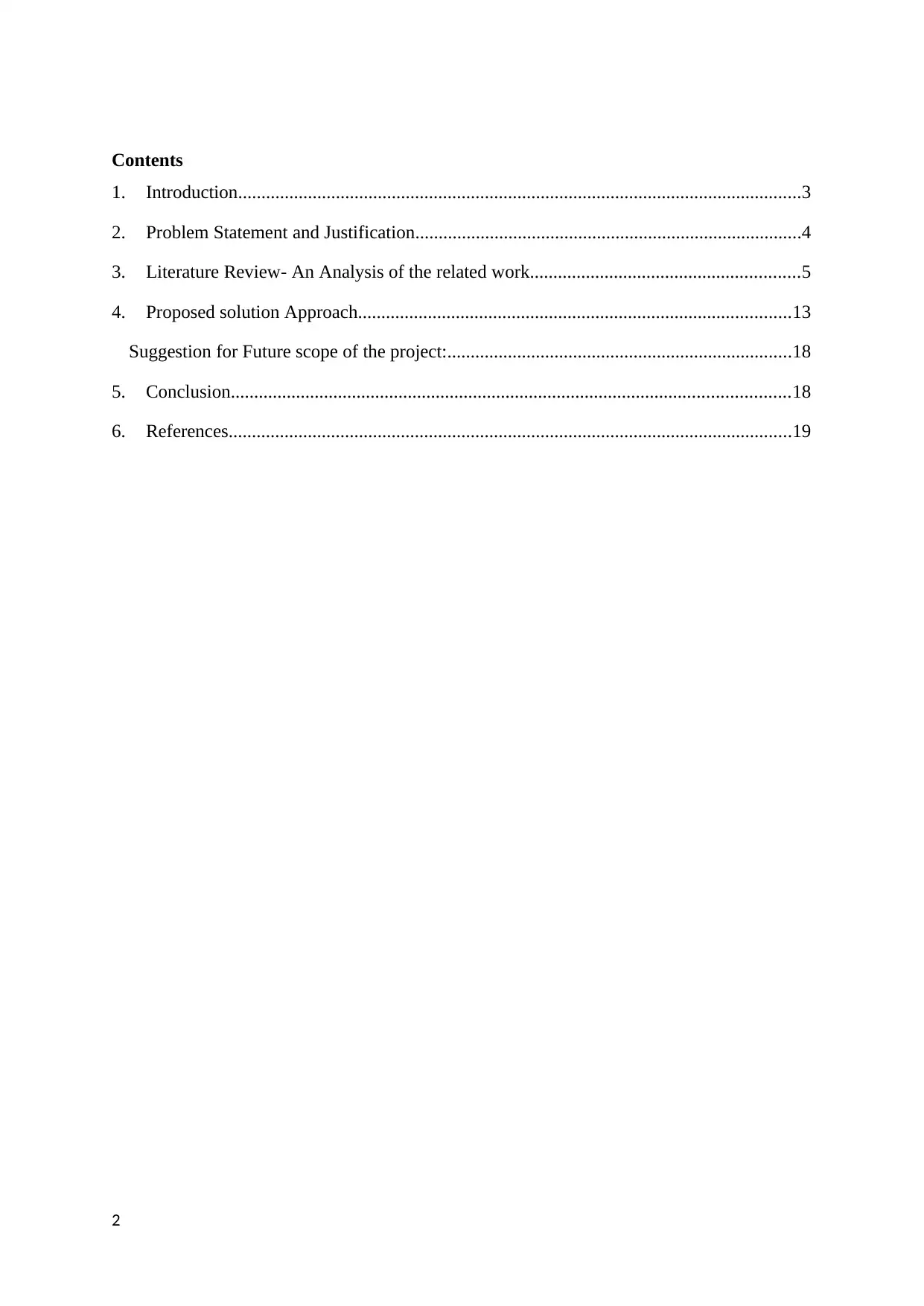
Contents
1. Introduction.........................................................................................................................3
2. Problem Statement and Justification...................................................................................4
3. Literature Review- An Analysis of the related work..........................................................5
4. Proposed solution Approach.............................................................................................13
Suggestion for Future scope of the project:..........................................................................18
5. Conclusion........................................................................................................................18
6. References.........................................................................................................................19
2
1. Introduction.........................................................................................................................3
2. Problem Statement and Justification...................................................................................4
3. Literature Review- An Analysis of the related work..........................................................5
4. Proposed solution Approach.............................................................................................13
Suggestion for Future scope of the project:..........................................................................18
5. Conclusion........................................................................................................................18
6. References.........................................................................................................................19
2
⊘ This is a preview!⊘
Do you want full access?
Subscribe today to unlock all pages.

Trusted by 1+ million students worldwide
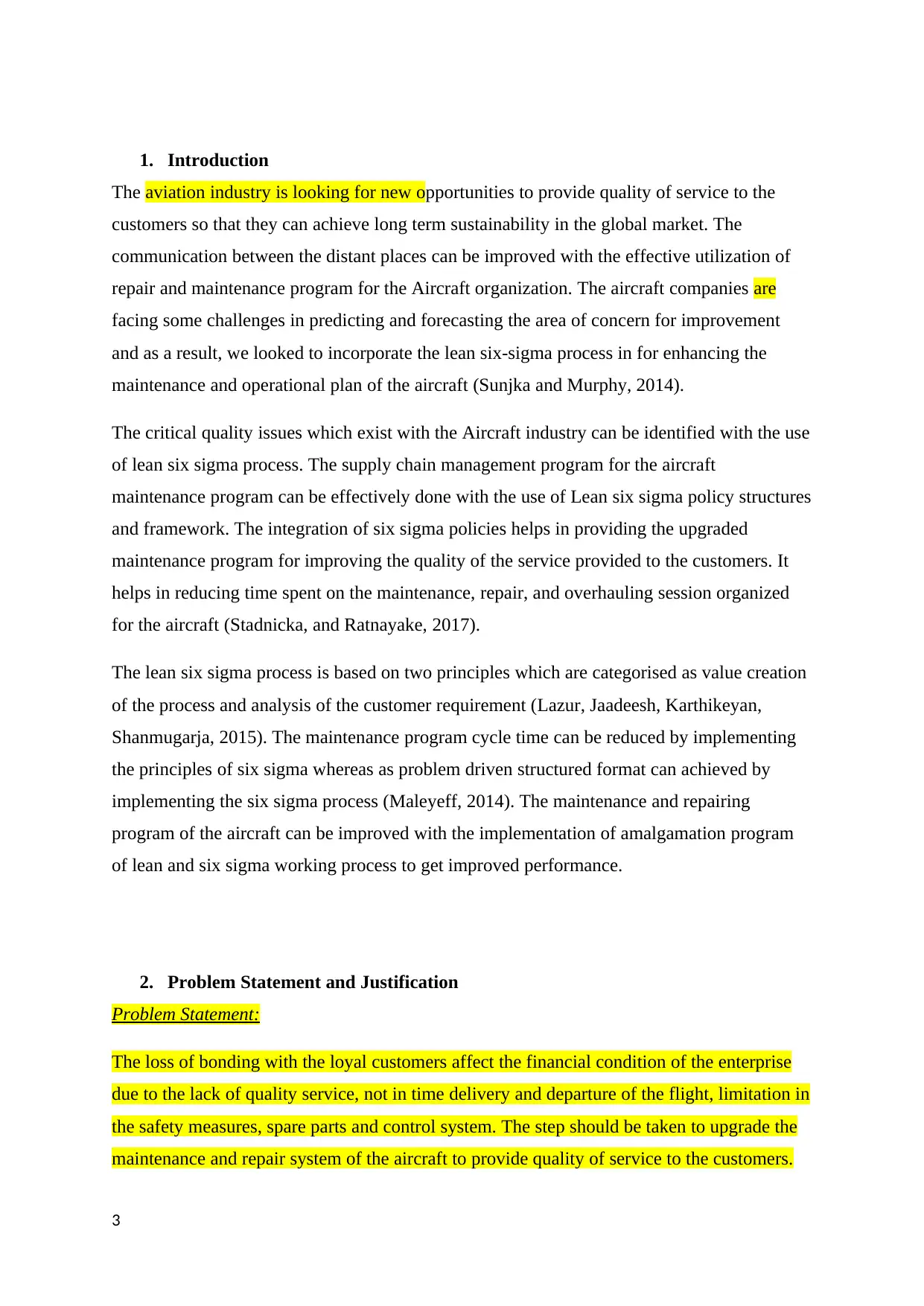
1. Introduction
The aviation industry is looking for new opportunities to provide quality of service to the
customers so that they can achieve long term sustainability in the global market. The
communication between the distant places can be improved with the effective utilization of
repair and maintenance program for the Aircraft organization. The aircraft companies are
facing some challenges in predicting and forecasting the area of concern for improvement
and as a result, we looked to incorporate the lean six-sigma process in for enhancing the
maintenance and operational plan of the aircraft (Sunjka and Murphy, 2014).
The critical quality issues which exist with the Aircraft industry can be identified with the use
of lean six sigma process. The supply chain management program for the aircraft
maintenance program can be effectively done with the use of Lean six sigma policy structures
and framework. The integration of six sigma policies helps in providing the upgraded
maintenance program for improving the quality of the service provided to the customers. It
helps in reducing time spent on the maintenance, repair, and overhauling session organized
for the aircraft (Stadnicka, and Ratnayake, 2017).
The lean six sigma process is based on two principles which are categorised as value creation
of the process and analysis of the customer requirement (Lazur, Jaadeesh, Karthikeyan,
Shanmugarja, 2015). The maintenance program cycle time can be reduced by implementing
the principles of six sigma whereas as problem driven structured format can achieved by
implementing the six sigma process (Maleyeff, 2014). The maintenance and repairing
program of the aircraft can be improved with the implementation of amalgamation program
of lean and six sigma working process to get improved performance.
2. Problem Statement and Justification
Problem Statement:
The loss of bonding with the loyal customers affect the financial condition of the enterprise
due to the lack of quality service, not in time delivery and departure of the flight, limitation in
the safety measures, spare parts and control system. The step should be taken to upgrade the
maintenance and repair system of the aircraft to provide quality of service to the customers.
3
The aviation industry is looking for new opportunities to provide quality of service to the
customers so that they can achieve long term sustainability in the global market. The
communication between the distant places can be improved with the effective utilization of
repair and maintenance program for the Aircraft organization. The aircraft companies are
facing some challenges in predicting and forecasting the area of concern for improvement
and as a result, we looked to incorporate the lean six-sigma process in for enhancing the
maintenance and operational plan of the aircraft (Sunjka and Murphy, 2014).
The critical quality issues which exist with the Aircraft industry can be identified with the use
of lean six sigma process. The supply chain management program for the aircraft
maintenance program can be effectively done with the use of Lean six sigma policy structures
and framework. The integration of six sigma policies helps in providing the upgraded
maintenance program for improving the quality of the service provided to the customers. It
helps in reducing time spent on the maintenance, repair, and overhauling session organized
for the aircraft (Stadnicka, and Ratnayake, 2017).
The lean six sigma process is based on two principles which are categorised as value creation
of the process and analysis of the customer requirement (Lazur, Jaadeesh, Karthikeyan,
Shanmugarja, 2015). The maintenance program cycle time can be reduced by implementing
the principles of six sigma whereas as problem driven structured format can achieved by
implementing the six sigma process (Maleyeff, 2014). The maintenance and repairing
program of the aircraft can be improved with the implementation of amalgamation program
of lean and six sigma working process to get improved performance.
2. Problem Statement and Justification
Problem Statement:
The loss of bonding with the loyal customers affect the financial condition of the enterprise
due to the lack of quality service, not in time delivery and departure of the flight, limitation in
the safety measures, spare parts and control system. The step should be taken to upgrade the
maintenance and repair system of the aircraft to provide quality of service to the customers.
3
Paraphrase This Document
Need a fresh take? Get an instant paraphrase of this document with our AI Paraphraser
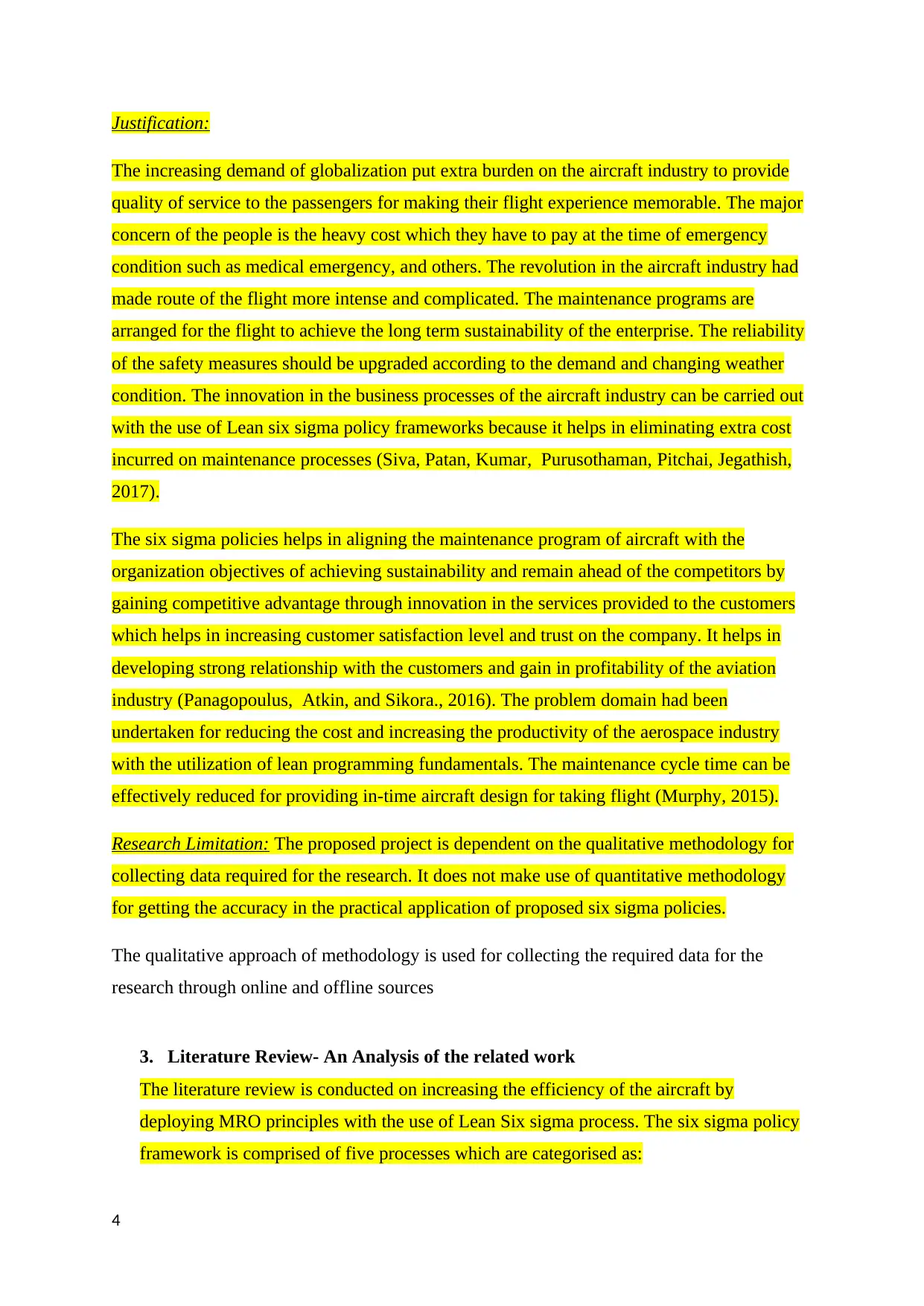
Justification:
The increasing demand of globalization put extra burden on the aircraft industry to provide
quality of service to the passengers for making their flight experience memorable. The major
concern of the people is the heavy cost which they have to pay at the time of emergency
condition such as medical emergency, and others. The revolution in the aircraft industry had
made route of the flight more intense and complicated. The maintenance programs are
arranged for the flight to achieve the long term sustainability of the enterprise. The reliability
of the safety measures should be upgraded according to the demand and changing weather
condition. The innovation in the business processes of the aircraft industry can be carried out
with the use of Lean six sigma policy frameworks because it helps in eliminating extra cost
incurred on maintenance processes (Siva, Patan, Kumar, Purusothaman, Pitchai, Jegathish,
2017).
The six sigma policies helps in aligning the maintenance program of aircraft with the
organization objectives of achieving sustainability and remain ahead of the competitors by
gaining competitive advantage through innovation in the services provided to the customers
which helps in increasing customer satisfaction level and trust on the company. It helps in
developing strong relationship with the customers and gain in profitability of the aviation
industry (Panagopoulus, Atkin, and Sikora., 2016). The problem domain had been
undertaken for reducing the cost and increasing the productivity of the aerospace industry
with the utilization of lean programming fundamentals. The maintenance cycle time can be
effectively reduced for providing in-time aircraft design for taking flight (Murphy, 2015).
Research Limitation: The proposed project is dependent on the qualitative methodology for
collecting data required for the research. It does not make use of quantitative methodology
for getting the accuracy in the practical application of proposed six sigma policies.
The qualitative approach of methodology is used for collecting the required data for the
research through online and offline sources
3. Literature Review- An Analysis of the related work
The literature review is conducted on increasing the efficiency of the aircraft by
deploying MRO principles with the use of Lean Six sigma process. The six sigma policy
framework is comprised of five processes which are categorised as:
4
The increasing demand of globalization put extra burden on the aircraft industry to provide
quality of service to the passengers for making their flight experience memorable. The major
concern of the people is the heavy cost which they have to pay at the time of emergency
condition such as medical emergency, and others. The revolution in the aircraft industry had
made route of the flight more intense and complicated. The maintenance programs are
arranged for the flight to achieve the long term sustainability of the enterprise. The reliability
of the safety measures should be upgraded according to the demand and changing weather
condition. The innovation in the business processes of the aircraft industry can be carried out
with the use of Lean six sigma policy frameworks because it helps in eliminating extra cost
incurred on maintenance processes (Siva, Patan, Kumar, Purusothaman, Pitchai, Jegathish,
2017).
The six sigma policies helps in aligning the maintenance program of aircraft with the
organization objectives of achieving sustainability and remain ahead of the competitors by
gaining competitive advantage through innovation in the services provided to the customers
which helps in increasing customer satisfaction level and trust on the company. It helps in
developing strong relationship with the customers and gain in profitability of the aviation
industry (Panagopoulus, Atkin, and Sikora., 2016). The problem domain had been
undertaken for reducing the cost and increasing the productivity of the aerospace industry
with the utilization of lean programming fundamentals. The maintenance cycle time can be
effectively reduced for providing in-time aircraft design for taking flight (Murphy, 2015).
Research Limitation: The proposed project is dependent on the qualitative methodology for
collecting data required for the research. It does not make use of quantitative methodology
for getting the accuracy in the practical application of proposed six sigma policies.
The qualitative approach of methodology is used for collecting the required data for the
research through online and offline sources
3. Literature Review- An Analysis of the related work
The literature review is conducted on increasing the efficiency of the aircraft by
deploying MRO principles with the use of Lean Six sigma process. The six sigma policy
framework is comprised of five processes which are categorised as:
4
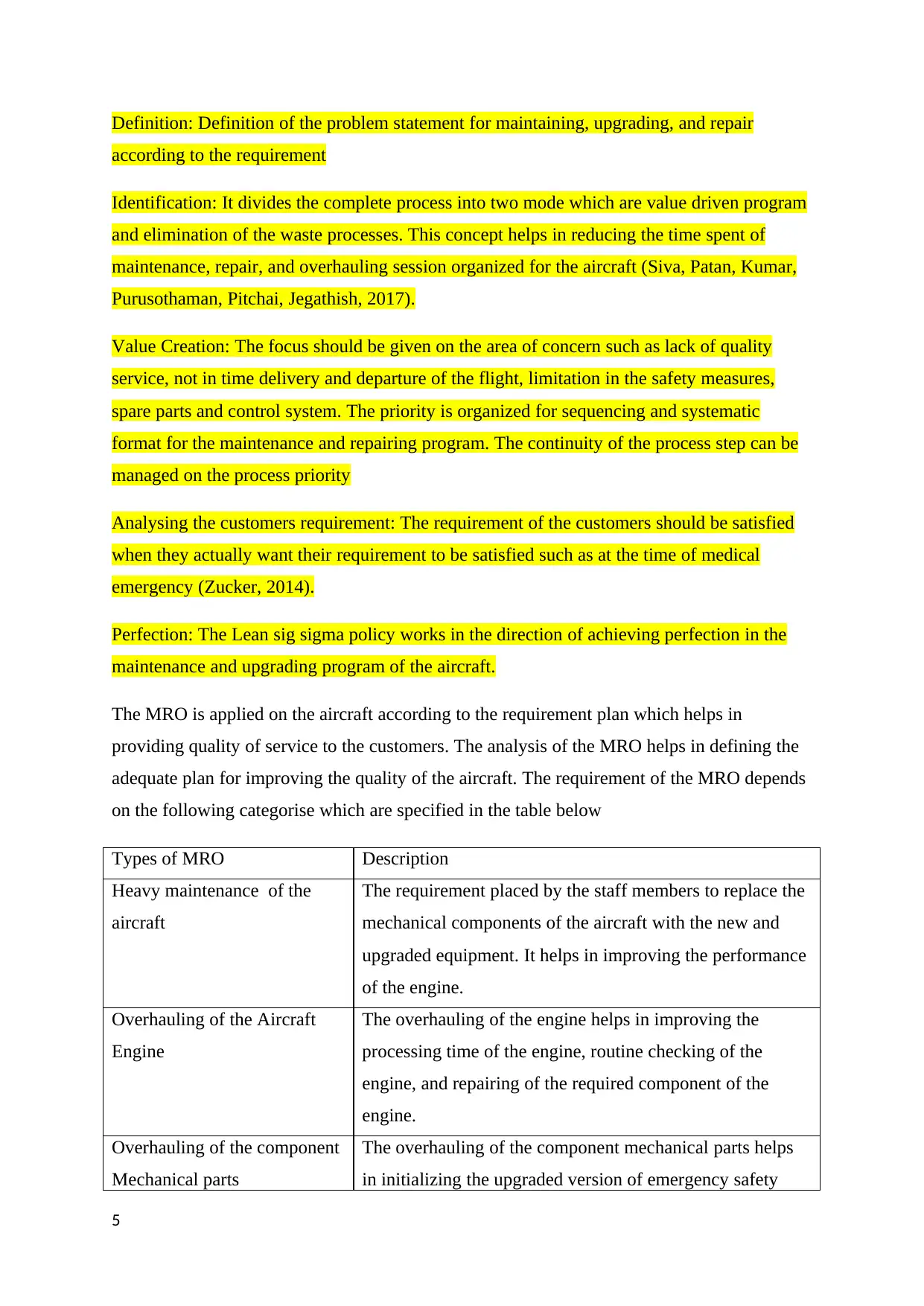
Definition: Definition of the problem statement for maintaining, upgrading, and repair
according to the requirement
Identification: It divides the complete process into two mode which are value driven program
and elimination of the waste processes. This concept helps in reducing the time spent of
maintenance, repair, and overhauling session organized for the aircraft (Siva, Patan, Kumar,
Purusothaman, Pitchai, Jegathish, 2017).
Value Creation: The focus should be given on the area of concern such as lack of quality
service, not in time delivery and departure of the flight, limitation in the safety measures,
spare parts and control system. The priority is organized for sequencing and systematic
format for the maintenance and repairing program. The continuity of the process step can be
managed on the process priority
Analysing the customers requirement: The requirement of the customers should be satisfied
when they actually want their requirement to be satisfied such as at the time of medical
emergency (Zucker, 2014).
Perfection: The Lean sig sigma policy works in the direction of achieving perfection in the
maintenance and upgrading program of the aircraft.
The MRO is applied on the aircraft according to the requirement plan which helps in
providing quality of service to the customers. The analysis of the MRO helps in defining the
adequate plan for improving the quality of the aircraft. The requirement of the MRO depends
on the following categorise which are specified in the table below
Types of MRO Description
Heavy maintenance of the
aircraft
The requirement placed by the staff members to replace the
mechanical components of the aircraft with the new and
upgraded equipment. It helps in improving the performance
of the engine.
Overhauling of the Aircraft
Engine
The overhauling of the engine helps in improving the
processing time of the engine, routine checking of the
engine, and repairing of the required component of the
engine.
Overhauling of the component
Mechanical parts
The overhauling of the component mechanical parts helps
in initializing the upgraded version of emergency safety
5
according to the requirement
Identification: It divides the complete process into two mode which are value driven program
and elimination of the waste processes. This concept helps in reducing the time spent of
maintenance, repair, and overhauling session organized for the aircraft (Siva, Patan, Kumar,
Purusothaman, Pitchai, Jegathish, 2017).
Value Creation: The focus should be given on the area of concern such as lack of quality
service, not in time delivery and departure of the flight, limitation in the safety measures,
spare parts and control system. The priority is organized for sequencing and systematic
format for the maintenance and repairing program. The continuity of the process step can be
managed on the process priority
Analysing the customers requirement: The requirement of the customers should be satisfied
when they actually want their requirement to be satisfied such as at the time of medical
emergency (Zucker, 2014).
Perfection: The Lean sig sigma policy works in the direction of achieving perfection in the
maintenance and upgrading program of the aircraft.
The MRO is applied on the aircraft according to the requirement plan which helps in
providing quality of service to the customers. The analysis of the MRO helps in defining the
adequate plan for improving the quality of the aircraft. The requirement of the MRO depends
on the following categorise which are specified in the table below
Types of MRO Description
Heavy maintenance of the
aircraft
The requirement placed by the staff members to replace the
mechanical components of the aircraft with the new and
upgraded equipment. It helps in improving the performance
of the engine.
Overhauling of the Aircraft
Engine
The overhauling of the engine helps in improving the
processing time of the engine, routine checking of the
engine, and repairing of the required component of the
engine.
Overhauling of the component
Mechanical parts
The overhauling of the component mechanical parts helps
in initializing the upgraded version of emergency safety
5
⊘ This is a preview!⊘
Do you want full access?
Subscribe today to unlock all pages.

Trusted by 1+ million students worldwide
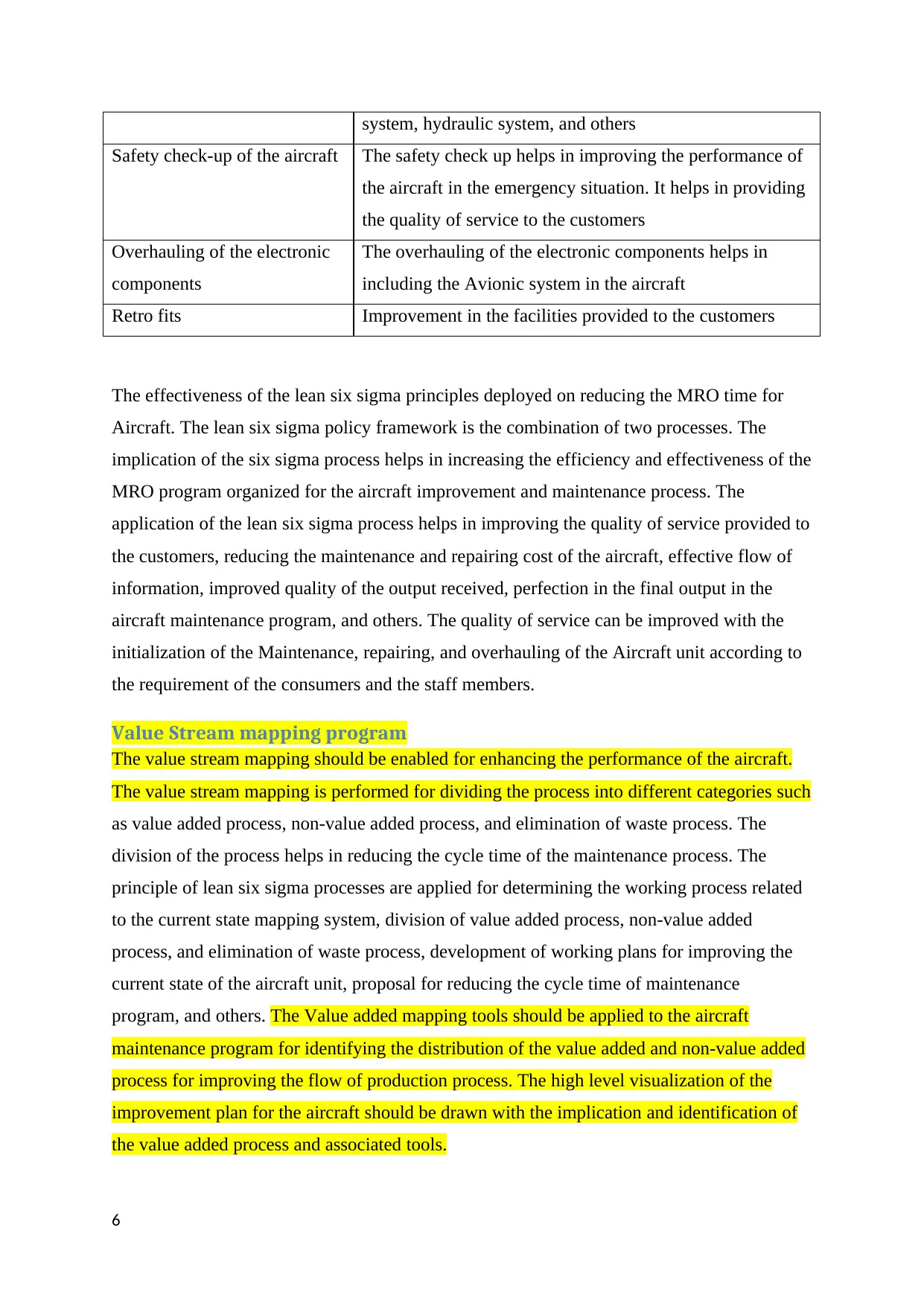
system, hydraulic system, and others
Safety check-up of the aircraft The safety check up helps in improving the performance of
the aircraft in the emergency situation. It helps in providing
the quality of service to the customers
Overhauling of the electronic
components
The overhauling of the electronic components helps in
including the Avionic system in the aircraft
Retro fits Improvement in the facilities provided to the customers
The effectiveness of the lean six sigma principles deployed on reducing the MRO time for
Aircraft. The lean six sigma policy framework is the combination of two processes. The
implication of the six sigma process helps in increasing the efficiency and effectiveness of the
MRO program organized for the aircraft improvement and maintenance process. The
application of the lean six sigma process helps in improving the quality of service provided to
the customers, reducing the maintenance and repairing cost of the aircraft, effective flow of
information, improved quality of the output received, perfection in the final output in the
aircraft maintenance program, and others. The quality of service can be improved with the
initialization of the Maintenance, repairing, and overhauling of the Aircraft unit according to
the requirement of the consumers and the staff members.
Value Stream mapping program
The value stream mapping should be enabled for enhancing the performance of the aircraft.
The value stream mapping is performed for dividing the process into different categories such
as value added process, non-value added process, and elimination of waste process. The
division of the process helps in reducing the cycle time of the maintenance process. The
principle of lean six sigma processes are applied for determining the working process related
to the current state mapping system, division of value added process, non-value added
process, and elimination of waste process, development of working plans for improving the
current state of the aircraft unit, proposal for reducing the cycle time of maintenance
program, and others. The Value added mapping tools should be applied to the aircraft
maintenance program for identifying the distribution of the value added and non-value added
process for improving the flow of production process. The high level visualization of the
improvement plan for the aircraft should be drawn with the implication and identification of
the value added process and associated tools.
6
Safety check-up of the aircraft The safety check up helps in improving the performance of
the aircraft in the emergency situation. It helps in providing
the quality of service to the customers
Overhauling of the electronic
components
The overhauling of the electronic components helps in
including the Avionic system in the aircraft
Retro fits Improvement in the facilities provided to the customers
The effectiveness of the lean six sigma principles deployed on reducing the MRO time for
Aircraft. The lean six sigma policy framework is the combination of two processes. The
implication of the six sigma process helps in increasing the efficiency and effectiveness of the
MRO program organized for the aircraft improvement and maintenance process. The
application of the lean six sigma process helps in improving the quality of service provided to
the customers, reducing the maintenance and repairing cost of the aircraft, effective flow of
information, improved quality of the output received, perfection in the final output in the
aircraft maintenance program, and others. The quality of service can be improved with the
initialization of the Maintenance, repairing, and overhauling of the Aircraft unit according to
the requirement of the consumers and the staff members.
Value Stream mapping program
The value stream mapping should be enabled for enhancing the performance of the aircraft.
The value stream mapping is performed for dividing the process into different categories such
as value added process, non-value added process, and elimination of waste process. The
division of the process helps in reducing the cycle time of the maintenance process. The
principle of lean six sigma processes are applied for determining the working process related
to the current state mapping system, division of value added process, non-value added
process, and elimination of waste process, development of working plans for improving the
current state of the aircraft unit, proposal for reducing the cycle time of maintenance
program, and others. The Value added mapping tools should be applied to the aircraft
maintenance program for identifying the distribution of the value added and non-value added
process for improving the flow of production process. The high level visualization of the
improvement plan for the aircraft should be drawn with the implication and identification of
the value added process and associated tools.
6
Paraphrase This Document
Need a fresh take? Get an instant paraphrase of this document with our AI Paraphraser
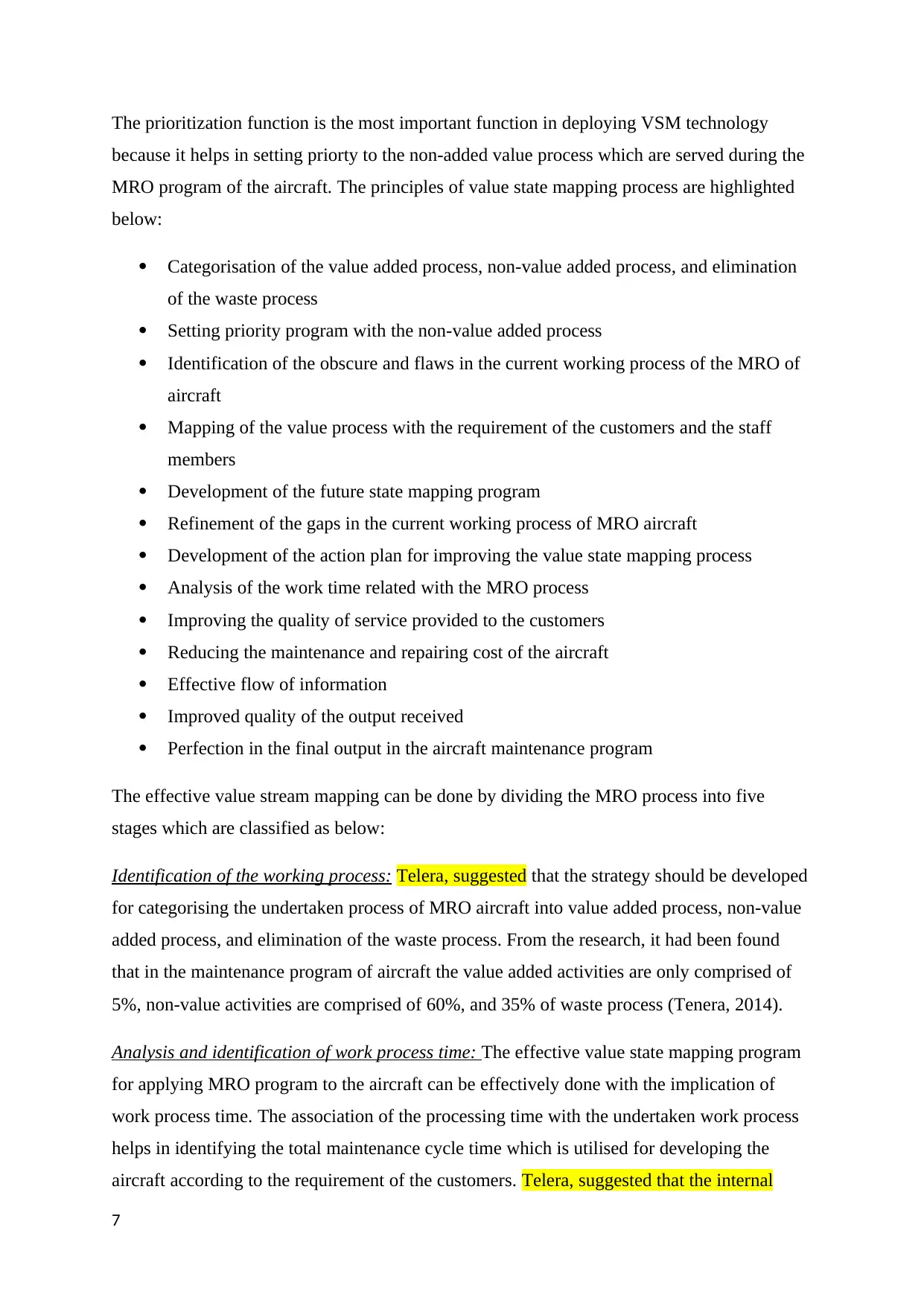
The prioritization function is the most important function in deploying VSM technology
because it helps in setting priorty to the non-added value process which are served during the
MRO program of the aircraft. The principles of value state mapping process are highlighted
below:
Categorisation of the value added process, non-value added process, and elimination
of the waste process
Setting priority program with the non-value added process
Identification of the obscure and flaws in the current working process of the MRO of
aircraft
Mapping of the value process with the requirement of the customers and the staff
members
Development of the future state mapping program
Refinement of the gaps in the current working process of MRO aircraft
Development of the action plan for improving the value state mapping process
Analysis of the work time related with the MRO process
Improving the quality of service provided to the customers
Reducing the maintenance and repairing cost of the aircraft
Effective flow of information
Improved quality of the output received
Perfection in the final output in the aircraft maintenance program
The effective value stream mapping can be done by dividing the MRO process into five
stages which are classified as below:
Identification of the working process: Telera, suggested that the strategy should be developed
for categorising the undertaken process of MRO aircraft into value added process, non-value
added process, and elimination of the waste process. From the research, it had been found
that in the maintenance program of aircraft the value added activities are only comprised of
5%, non-value activities are comprised of 60%, and 35% of waste process (Tenera, 2014).
Analysis and identification of work process time: The effective value state mapping program
for applying MRO program to the aircraft can be effectively done with the implication of
work process time. The association of the processing time with the undertaken work process
helps in identifying the total maintenance cycle time which is utilised for developing the
aircraft according to the requirement of the customers. Telera, suggested that the internal
7
because it helps in setting priorty to the non-added value process which are served during the
MRO program of the aircraft. The principles of value state mapping process are highlighted
below:
Categorisation of the value added process, non-value added process, and elimination
of the waste process
Setting priority program with the non-value added process
Identification of the obscure and flaws in the current working process of the MRO of
aircraft
Mapping of the value process with the requirement of the customers and the staff
members
Development of the future state mapping program
Refinement of the gaps in the current working process of MRO aircraft
Development of the action plan for improving the value state mapping process
Analysis of the work time related with the MRO process
Improving the quality of service provided to the customers
Reducing the maintenance and repairing cost of the aircraft
Effective flow of information
Improved quality of the output received
Perfection in the final output in the aircraft maintenance program
The effective value stream mapping can be done by dividing the MRO process into five
stages which are classified as below:
Identification of the working process: Telera, suggested that the strategy should be developed
for categorising the undertaken process of MRO aircraft into value added process, non-value
added process, and elimination of the waste process. From the research, it had been found
that in the maintenance program of aircraft the value added activities are only comprised of
5%, non-value activities are comprised of 60%, and 35% of waste process (Tenera, 2014).
Analysis and identification of work process time: The effective value state mapping program
for applying MRO program to the aircraft can be effectively done with the implication of
work process time. The association of the processing time with the undertaken work process
helps in identifying the total maintenance cycle time which is utilised for developing the
aircraft according to the requirement of the customers. Telera, suggested that the internal
7
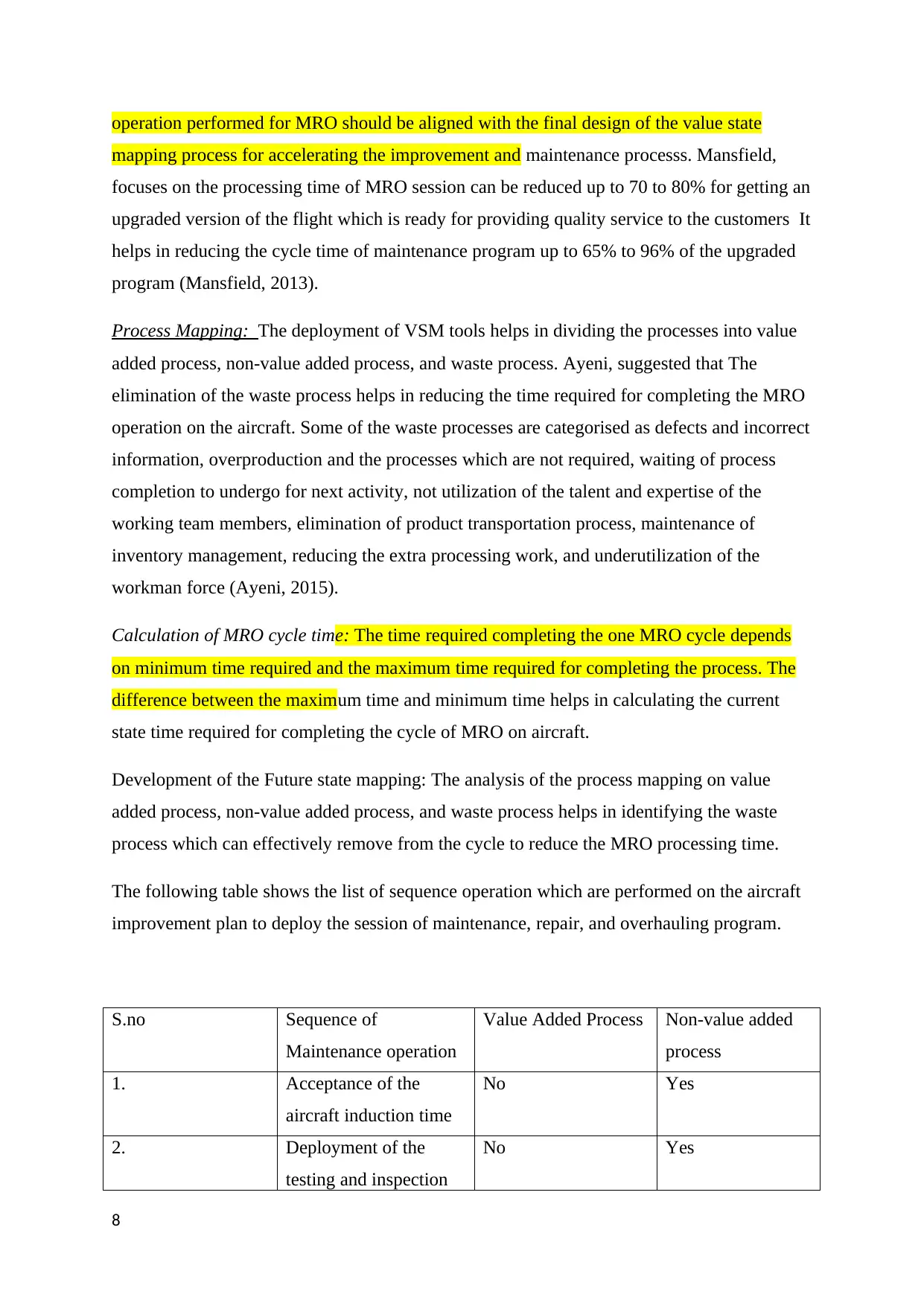
operation performed for MRO should be aligned with the final design of the value state
mapping process for accelerating the improvement and maintenance processs. Mansfield,
focuses on the processing time of MRO session can be reduced up to 70 to 80% for getting an
upgraded version of the flight which is ready for providing quality service to the customers It
helps in reducing the cycle time of maintenance program up to 65% to 96% of the upgraded
program (Mansfield, 2013).
Process Mapping: The deployment of VSM tools helps in dividing the processes into value
added process, non-value added process, and waste process. Ayeni, suggested that The
elimination of the waste process helps in reducing the time required for completing the MRO
operation on the aircraft. Some of the waste processes are categorised as defects and incorrect
information, overproduction and the processes which are not required, waiting of process
completion to undergo for next activity, not utilization of the talent and expertise of the
working team members, elimination of product transportation process, maintenance of
inventory management, reducing the extra processing work, and underutilization of the
workman force (Ayeni, 2015).
Calculation of MRO cycle time: The time required completing the one MRO cycle depends
on minimum time required and the maximum time required for completing the process. The
difference between the maximum time and minimum time helps in calculating the current
state time required for completing the cycle of MRO on aircraft.
Development of the Future state mapping: The analysis of the process mapping on value
added process, non-value added process, and waste process helps in identifying the waste
process which can effectively remove from the cycle to reduce the MRO processing time.
The following table shows the list of sequence operation which are performed on the aircraft
improvement plan to deploy the session of maintenance, repair, and overhauling program.
S.no Sequence of
Maintenance operation
Value Added Process Non-value added
process
1. Acceptance of the
aircraft induction time
No Yes
2. Deployment of the
testing and inspection
No Yes
8
mapping process for accelerating the improvement and maintenance processs. Mansfield,
focuses on the processing time of MRO session can be reduced up to 70 to 80% for getting an
upgraded version of the flight which is ready for providing quality service to the customers It
helps in reducing the cycle time of maintenance program up to 65% to 96% of the upgraded
program (Mansfield, 2013).
Process Mapping: The deployment of VSM tools helps in dividing the processes into value
added process, non-value added process, and waste process. Ayeni, suggested that The
elimination of the waste process helps in reducing the time required for completing the MRO
operation on the aircraft. Some of the waste processes are categorised as defects and incorrect
information, overproduction and the processes which are not required, waiting of process
completion to undergo for next activity, not utilization of the talent and expertise of the
working team members, elimination of product transportation process, maintenance of
inventory management, reducing the extra processing work, and underutilization of the
workman force (Ayeni, 2015).
Calculation of MRO cycle time: The time required completing the one MRO cycle depends
on minimum time required and the maximum time required for completing the process. The
difference between the maximum time and minimum time helps in calculating the current
state time required for completing the cycle of MRO on aircraft.
Development of the Future state mapping: The analysis of the process mapping on value
added process, non-value added process, and waste process helps in identifying the waste
process which can effectively remove from the cycle to reduce the MRO processing time.
The following table shows the list of sequence operation which are performed on the aircraft
improvement plan to deploy the session of maintenance, repair, and overhauling program.
S.no Sequence of
Maintenance operation
Value Added Process Non-value added
process
1. Acceptance of the
aircraft induction time
No Yes
2. Deployment of the
testing and inspection
No Yes
8
⊘ This is a preview!⊘
Do you want full access?
Subscribe today to unlock all pages.

Trusted by 1+ million students worldwide
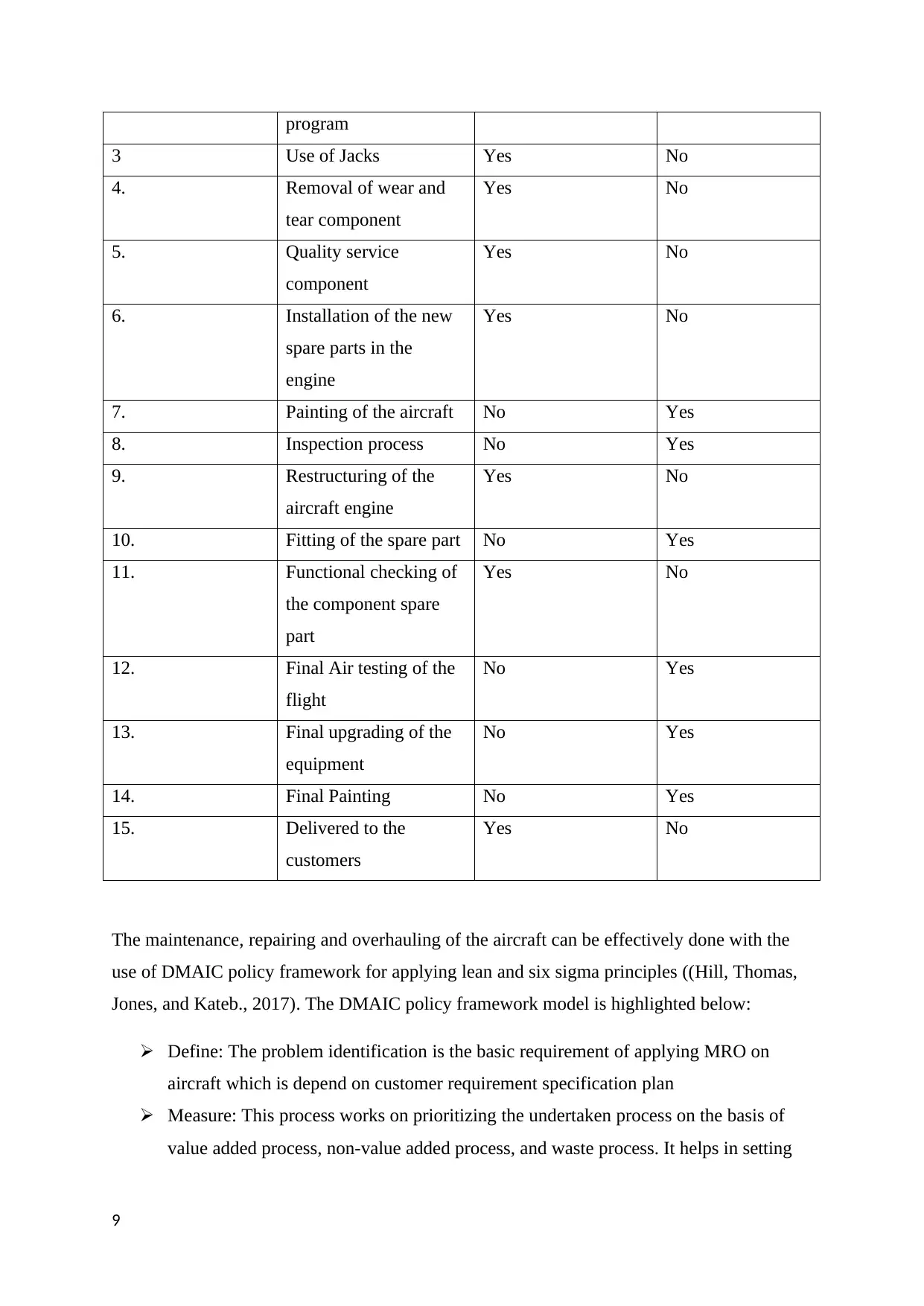
program
3 Use of Jacks Yes No
4. Removal of wear and
tear component
Yes No
5. Quality service
component
Yes No
6. Installation of the new
spare parts in the
engine
Yes No
7. Painting of the aircraft No Yes
8. Inspection process No Yes
9. Restructuring of the
aircraft engine
Yes No
10. Fitting of the spare part No Yes
11. Functional checking of
the component spare
part
Yes No
12. Final Air testing of the
flight
No Yes
13. Final upgrading of the
equipment
No Yes
14. Final Painting No Yes
15. Delivered to the
customers
Yes No
The maintenance, repairing and overhauling of the aircraft can be effectively done with the
use of DMAIC policy framework for applying lean and six sigma principles ((Hill, Thomas,
Jones, and Kateb., 2017). The DMAIC policy framework model is highlighted below:
Define: The problem identification is the basic requirement of applying MRO on
aircraft which is depend on customer requirement specification plan
Measure: This process works on prioritizing the undertaken process on the basis of
value added process, non-value added process, and waste process. It helps in setting
9
3 Use of Jacks Yes No
4. Removal of wear and
tear component
Yes No
5. Quality service
component
Yes No
6. Installation of the new
spare parts in the
engine
Yes No
7. Painting of the aircraft No Yes
8. Inspection process No Yes
9. Restructuring of the
aircraft engine
Yes No
10. Fitting of the spare part No Yes
11. Functional checking of
the component spare
part
Yes No
12. Final Air testing of the
flight
No Yes
13. Final upgrading of the
equipment
No Yes
14. Final Painting No Yes
15. Delivered to the
customers
Yes No
The maintenance, repairing and overhauling of the aircraft can be effectively done with the
use of DMAIC policy framework for applying lean and six sigma principles ((Hill, Thomas,
Jones, and Kateb., 2017). The DMAIC policy framework model is highlighted below:
Define: The problem identification is the basic requirement of applying MRO on
aircraft which is depend on customer requirement specification plan
Measure: This process works on prioritizing the undertaken process on the basis of
value added process, non-value added process, and waste process. It helps in setting
9
Paraphrase This Document
Need a fresh take? Get an instant paraphrase of this document with our AI Paraphraser
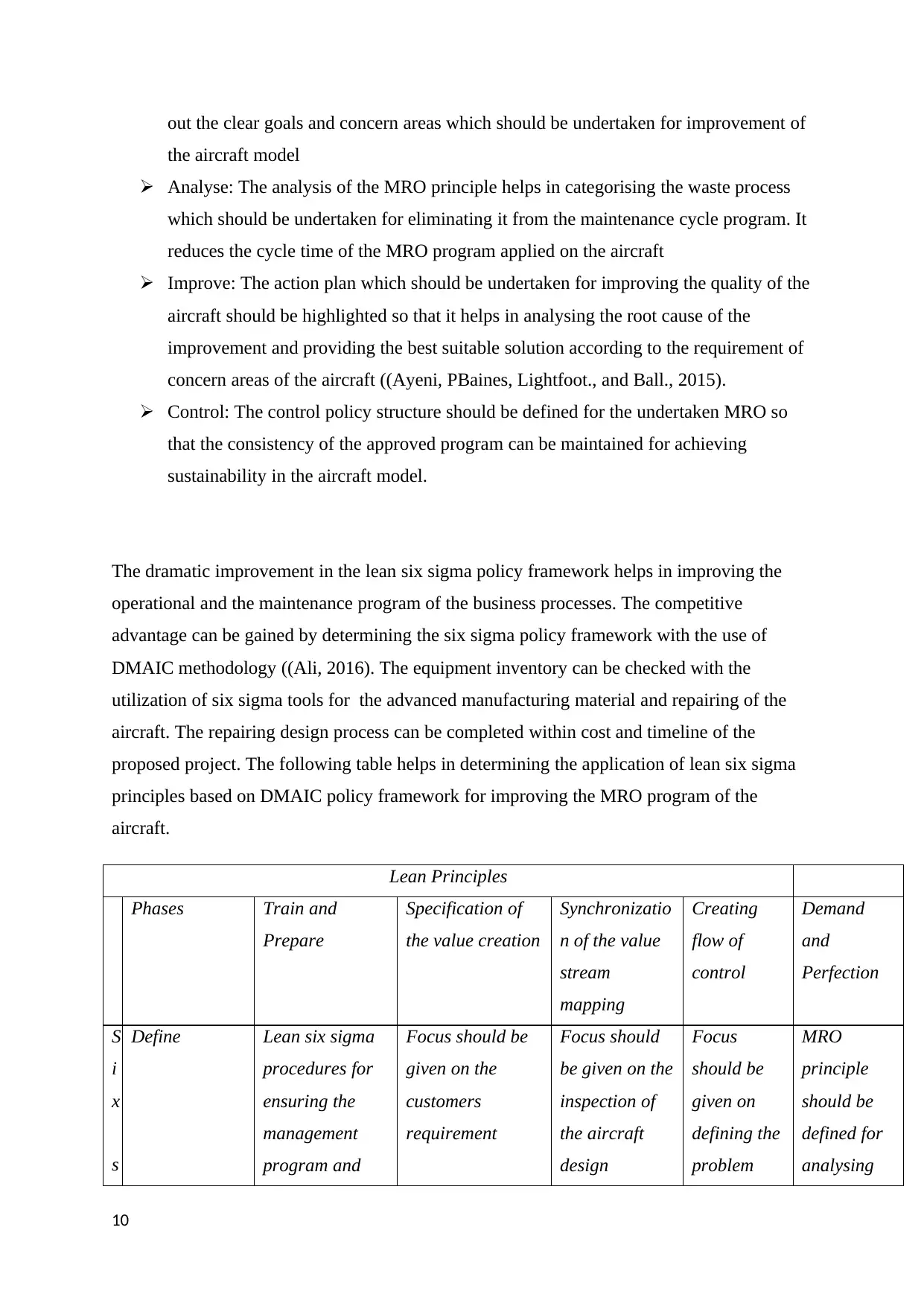
out the clear goals and concern areas which should be undertaken for improvement of
the aircraft model
Analyse: The analysis of the MRO principle helps in categorising the waste process
which should be undertaken for eliminating it from the maintenance cycle program. It
reduces the cycle time of the MRO program applied on the aircraft
Improve: The action plan which should be undertaken for improving the quality of the
aircraft should be highlighted so that it helps in analysing the root cause of the
improvement and providing the best suitable solution according to the requirement of
concern areas of the aircraft ((Ayeni, PBaines, Lightfoot., and Ball., 2015).
Control: The control policy structure should be defined for the undertaken MRO so
that the consistency of the approved program can be maintained for achieving
sustainability in the aircraft model.
The dramatic improvement in the lean six sigma policy framework helps in improving the
operational and the maintenance program of the business processes. The competitive
advantage can be gained by determining the six sigma policy framework with the use of
DMAIC methodology ((Ali, 2016). The equipment inventory can be checked with the
utilization of six sigma tools for the advanced manufacturing material and repairing of the
aircraft. The repairing design process can be completed within cost and timeline of the
proposed project. The following table helps in determining the application of lean six sigma
principles based on DMAIC policy framework for improving the MRO program of the
aircraft.
Lean Principles
Phases Train and
Prepare
Specification of
the value creation
Synchronizatio
n of the value
stream
mapping
Creating
flow of
control
Demand
and
Perfection
S
i
x
s
Define Lean six sigma
procedures for
ensuring the
management
program and
Focus should be
given on the
customers
requirement
Focus should
be given on the
inspection of
the aircraft
design
Focus
should be
given on
defining the
problem
MRO
principle
should be
defined for
analysing
10
the aircraft model
Analyse: The analysis of the MRO principle helps in categorising the waste process
which should be undertaken for eliminating it from the maintenance cycle program. It
reduces the cycle time of the MRO program applied on the aircraft
Improve: The action plan which should be undertaken for improving the quality of the
aircraft should be highlighted so that it helps in analysing the root cause of the
improvement and providing the best suitable solution according to the requirement of
concern areas of the aircraft ((Ayeni, PBaines, Lightfoot., and Ball., 2015).
Control: The control policy structure should be defined for the undertaken MRO so
that the consistency of the approved program can be maintained for achieving
sustainability in the aircraft model.
The dramatic improvement in the lean six sigma policy framework helps in improving the
operational and the maintenance program of the business processes. The competitive
advantage can be gained by determining the six sigma policy framework with the use of
DMAIC methodology ((Ali, 2016). The equipment inventory can be checked with the
utilization of six sigma tools for the advanced manufacturing material and repairing of the
aircraft. The repairing design process can be completed within cost and timeline of the
proposed project. The following table helps in determining the application of lean six sigma
principles based on DMAIC policy framework for improving the MRO program of the
aircraft.
Lean Principles
Phases Train and
Prepare
Specification of
the value creation
Synchronizatio
n of the value
stream
mapping
Creating
flow of
control
Demand
and
Perfection
S
i
x
s
Define Lean six sigma
procedures for
ensuring the
management
program and
Focus should be
given on the
customers
requirement
Focus should
be given on the
inspection of
the aircraft
design
Focus
should be
given on
defining the
problem
MRO
principle
should be
defined for
analysing
10
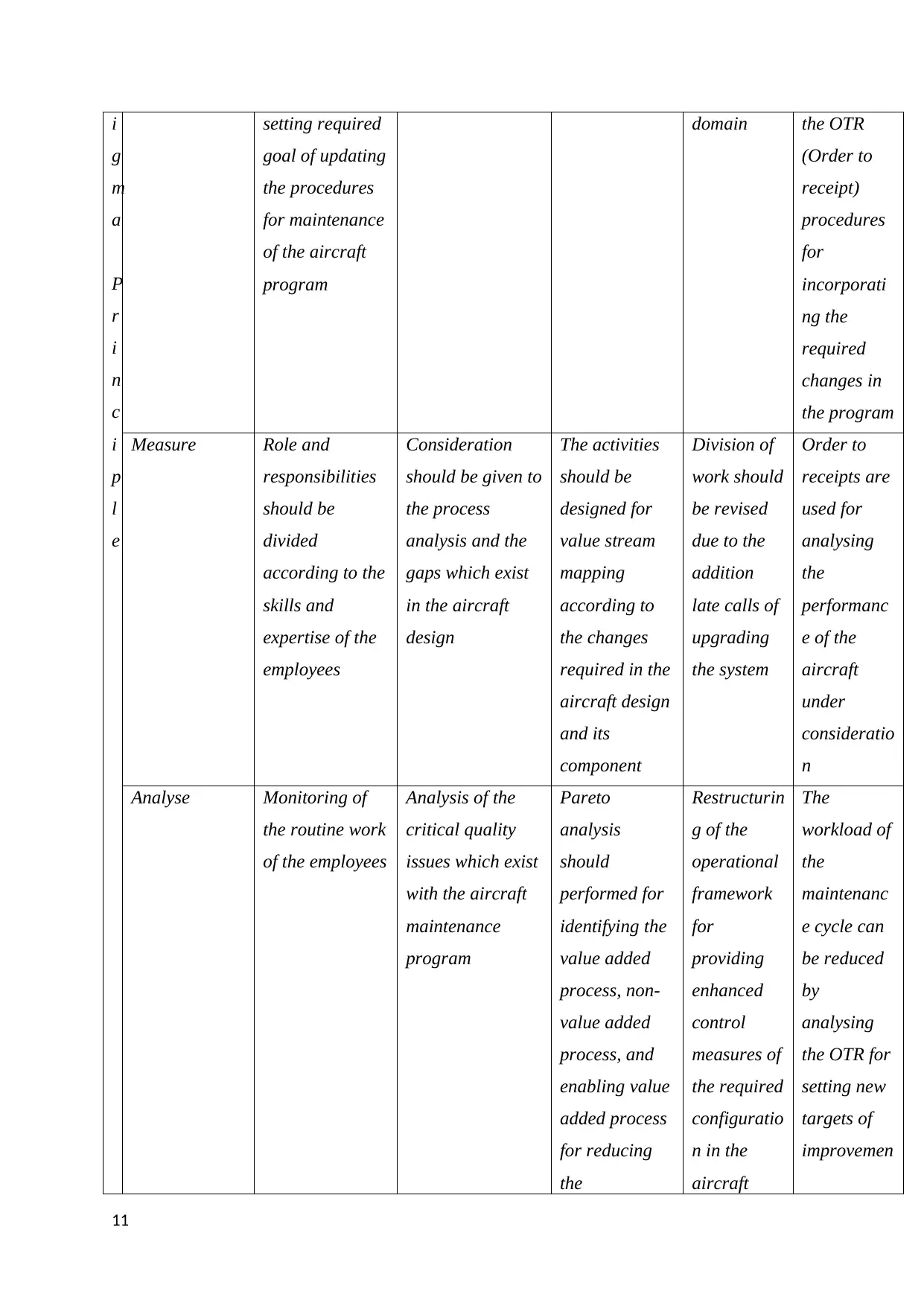
i
g
m
a
P
r
i
n
c
i
p
l
e
setting required
goal of updating
the procedures
for maintenance
of the aircraft
program
domain the OTR
(Order to
receipt)
procedures
for
incorporati
ng the
required
changes in
the program
Measure Role and
responsibilities
should be
divided
according to the
skills and
expertise of the
employees
Consideration
should be given to
the process
analysis and the
gaps which exist
in the aircraft
design
The activities
should be
designed for
value stream
mapping
according to
the changes
required in the
aircraft design
and its
component
Division of
work should
be revised
due to the
addition
late calls of
upgrading
the system
Order to
receipts are
used for
analysing
the
performanc
e of the
aircraft
under
consideratio
n
Analyse Monitoring of
the routine work
of the employees
Analysis of the
critical quality
issues which exist
with the aircraft
maintenance
program
Pareto
analysis
should
performed for
identifying the
value added
process, non-
value added
process, and
enabling value
added process
for reducing
the
Restructurin
g of the
operational
framework
for
providing
enhanced
control
measures of
the required
configuratio
n in the
aircraft
The
workload of
the
maintenanc
e cycle can
be reduced
by
analysing
the OTR for
setting new
targets of
improvemen
11
g
m
a
P
r
i
n
c
i
p
l
e
setting required
goal of updating
the procedures
for maintenance
of the aircraft
program
domain the OTR
(Order to
receipt)
procedures
for
incorporati
ng the
required
changes in
the program
Measure Role and
responsibilities
should be
divided
according to the
skills and
expertise of the
employees
Consideration
should be given to
the process
analysis and the
gaps which exist
in the aircraft
design
The activities
should be
designed for
value stream
mapping
according to
the changes
required in the
aircraft design
and its
component
Division of
work should
be revised
due to the
addition
late calls of
upgrading
the system
Order to
receipts are
used for
analysing
the
performanc
e of the
aircraft
under
consideratio
n
Analyse Monitoring of
the routine work
of the employees
Analysis of the
critical quality
issues which exist
with the aircraft
maintenance
program
Pareto
analysis
should
performed for
identifying the
value added
process, non-
value added
process, and
enabling value
added process
for reducing
the
Restructurin
g of the
operational
framework
for
providing
enhanced
control
measures of
the required
configuratio
n in the
aircraft
The
workload of
the
maintenanc
e cycle can
be reduced
by
analysing
the OTR for
setting new
targets of
improvemen
11
⊘ This is a preview!⊘
Do you want full access?
Subscribe today to unlock all pages.

Trusted by 1+ million students worldwide
1 out of 22
Related Documents
Your All-in-One AI-Powered Toolkit for Academic Success.
+13062052269
info@desklib.com
Available 24*7 on WhatsApp / Email
![[object Object]](/_next/static/media/star-bottom.7253800d.svg)
Unlock your academic potential
Copyright © 2020–2025 A2Z Services. All Rights Reserved. Developed and managed by ZUCOL.





